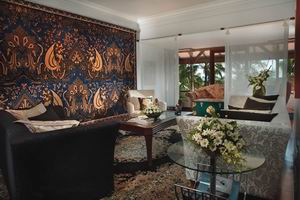Book Review: Grand Batik Interiors
 Many books have been written about batik, but Grand Batik Interiors is arguably the first that highlights the debut of batik into the world of interior design, presenting a fresh new perspective on this most ancient of crafts. Published by Buku Antar Bangsa (BAB) Publishing Indonesia – the publishing house that initiated the highly acclaimed Indonesian Heritage Series and other breakthrough publications on Indonesian arts and cultures – Grand Batik Interiors unravels the historical trajectory of batik as the article in the Bali Discovery explains.
Many books have been written about batik, but Grand Batik Interiors is arguably the first that highlights the debut of batik into the world of interior design, presenting a fresh new perspective on this most ancient of crafts. Published by Buku Antar Bangsa (BAB) Publishing Indonesia – the publishing house that initiated the highly acclaimed Indonesian Heritage Series and other breakthrough publications on Indonesian arts and cultures – Grand Batik Interiors unravels the historical trajectory of batik as the article in the Bali Discovery explains.
The book records batik’s transformation from its traditional context into the world of modernity. It examines the way this cloth with its deeply embedded, multi-layered meanings has been re-created to become relevant to a modern lifestyle, including its use in the garment/ fashion, and interior design industries. The book’s mastermind, former Minister of Tourism and Telecommunications, Joop Avé, was the first person to encourage Indonesian batik masters to venture out into interior design by commissioning them to create enlarged batik motif wall hangings. In the 1970s designers like Iwan Tirta, Ardiyanto and Harry Soeharyo, to name just a few of the batik movement’s pioneers, responded to Joop Avé’s call and were creating innovative and original batiks for interior design.

By the 2000s, a new generation of batik designers had emerged, treading the path once opened by their seniors, and which led to the blossoming of a new local industry. The old pioneering masters, meanwhile, consolidated their works. The book examines the way that these designers have adapted batik motifs to silver, ceramic, wood and leather.
Joop Avé invited four authors to share their insights and expertise on batik and its foray into the realm of interior design.
• Professor Michael Hitchcock, an Indonesian textile expert who is now a Director of the International Institute for Culture, Tourism and Development at London Metropolitan University, unfolds the history of batik as a cultural and artistic language, by tracing its roots back to ancient times.
• Soedarmadji J.H. Damais, an independent scholar knowledgeable about batik and various facets of the world’s cultures, points at specific historical and style junctures when batik entered people’s homes, from the early expatriates in the former Dutch East Indies and beyond as faraway art connoisseurs such as a French Baroness in the contemporary world, adapted batik for interiors.
• Dr Wiendu Nuryanti, a Professor of Architecture and Tourism Planning at Gadjah Mada University in Yogyakarta, and an expert on tourism gives her insightful account on batik influences in the rapidly expanding hospitality industry.
• Dr. Sian Jay, an anthropologist and design expert, wraps up the discussion by interviewing some of the most influential batik designers about their experimentation with batik for interior design purposes.
Grand Batik Interiors is lavishly illustrated, with detailed descriptions of the interiors, methods, concepts and ideas that are featured throughout. Aimed at a general readership interested in art and design, Grand Batik Interiors is also intended to appeal to those interested in interior decoration, furnishings and décor, and for anyone looking for ideas and inspiration.
Grand Batik Interior is printed on high quality paper 150-gramme matt art paper in coffee-table format measuring 270 mm x 270 mm, 228 pages.
The book is available at Periplus Bookshops throughout Indonesia.
ISBN 978-979-8926-26-6.